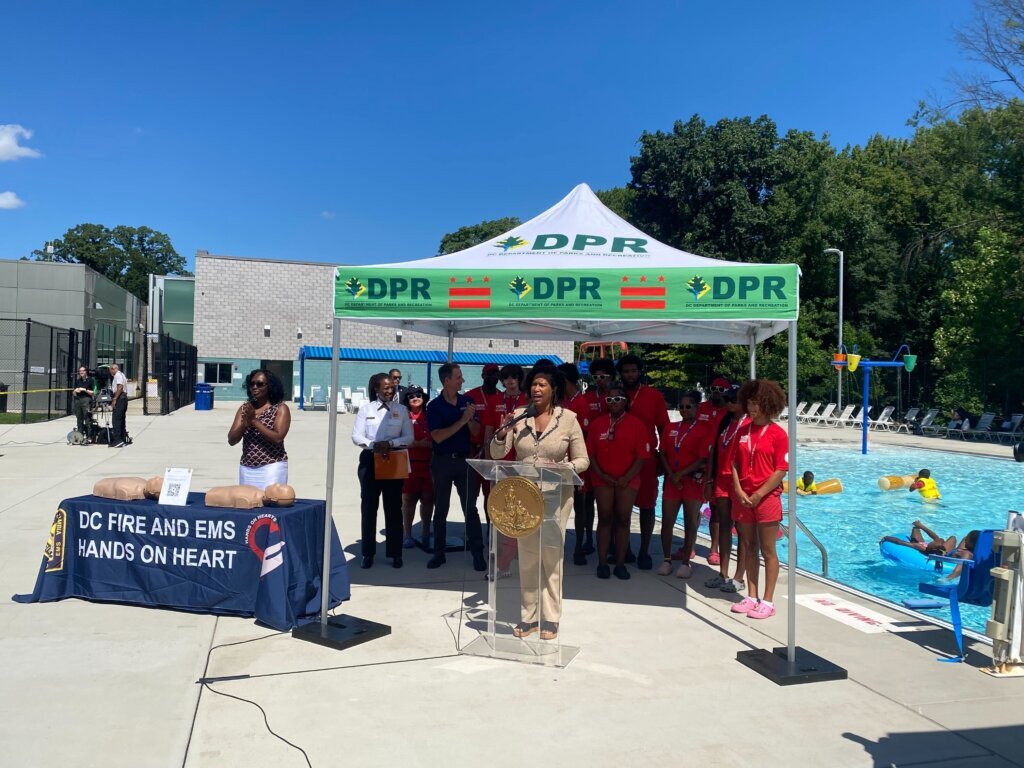
Since Memorial Day, hundreds of thousands of people have walked into one of the many neighborhood pools around the District to take a dip and cool off.
A handful of times, those swimmers couldn’t make it out of the water themselves, and instead needed help from a lifeguard who was on duty. During an event touting a new program aimed at recruiting more lifeguards in the city, District leaders made sure to honor those who stepped up to the challenge when it was needed most.
Almost a dozen lifeguards from pools across the city were acknowledged on Wednesday. The list included Timeera Niles, who works at the Fort Stanton pool and saved the life of a young boy just a few weeks ago.
Niles recounted seeing a three-year-old child’s body drop. The child wasn’t in a deep part of the pool, but at such a young age, even the shallow end can be too deep.
“By the time I got to him, he was still conscious but his face was just in shock,” she said.
Because the child was struggling to breathe, they called 911 to assist.
“A couple of days after it happened, I saw him again and he was happy and he was running around,” she said, which left her feeling a lot better.
One of her co-workers at the pool, Michael Pearson, was honored for his own save there as well.
“I always look at people go down and see how they react when they come up,” Pearson said. “Naturally, your body will bring you up once. But that’s it if you can’t swim.”
When a young boy jumped into the pool next to him, he noticed quickly that he wasn’t getting more than his nose above the water, and sprung into action. Pearson was able to get the boy out of the water and back with his parents in a matter of seconds.
“If I see a new face, I’m immediately going to expect that you can’t swim, no matter [what], I don’t care if you’re grown or a child,” Pearson said. “Until I see you can swim, I’m going to expect you can’t.”
He’s worked at Fort Stanton long enough to know a lot of the faces there, but that boy wasn’t one of them.
“When I saw him hop in, I immediately made sure I watched to see if he would come back up,” Pearson said. “I had to react the fast way.”
Thennie Freeman, the new Director of D.C.’s Department of Recreation, said that out of the more than 300,000 visits to city pools this summer, DC Fire and EMS has only been called 11 times to evaluate someone who had been rescued. She calls the lifeguards who work at city pools “amazing” and said the city tries to be there for its lifeguards when they’re there for city residents.
“We provide them with trauma counseling because it is a traumatic experience for them,” Freeman said. “We offer them an opportunity to debrief and teach them strategies so it’s not overwhelming and that they don’t develop a fear of the water themselves.”
Niles said she went through that emotional roller coaster after saving the three-year-old.
“It was traumatic,” Niles said. “He was so young. He was three years old. Then it made me scared to get in the chair sometimes, but … after I calmed down and realized we did save a life and he’s OK, I continued to do my job.”








